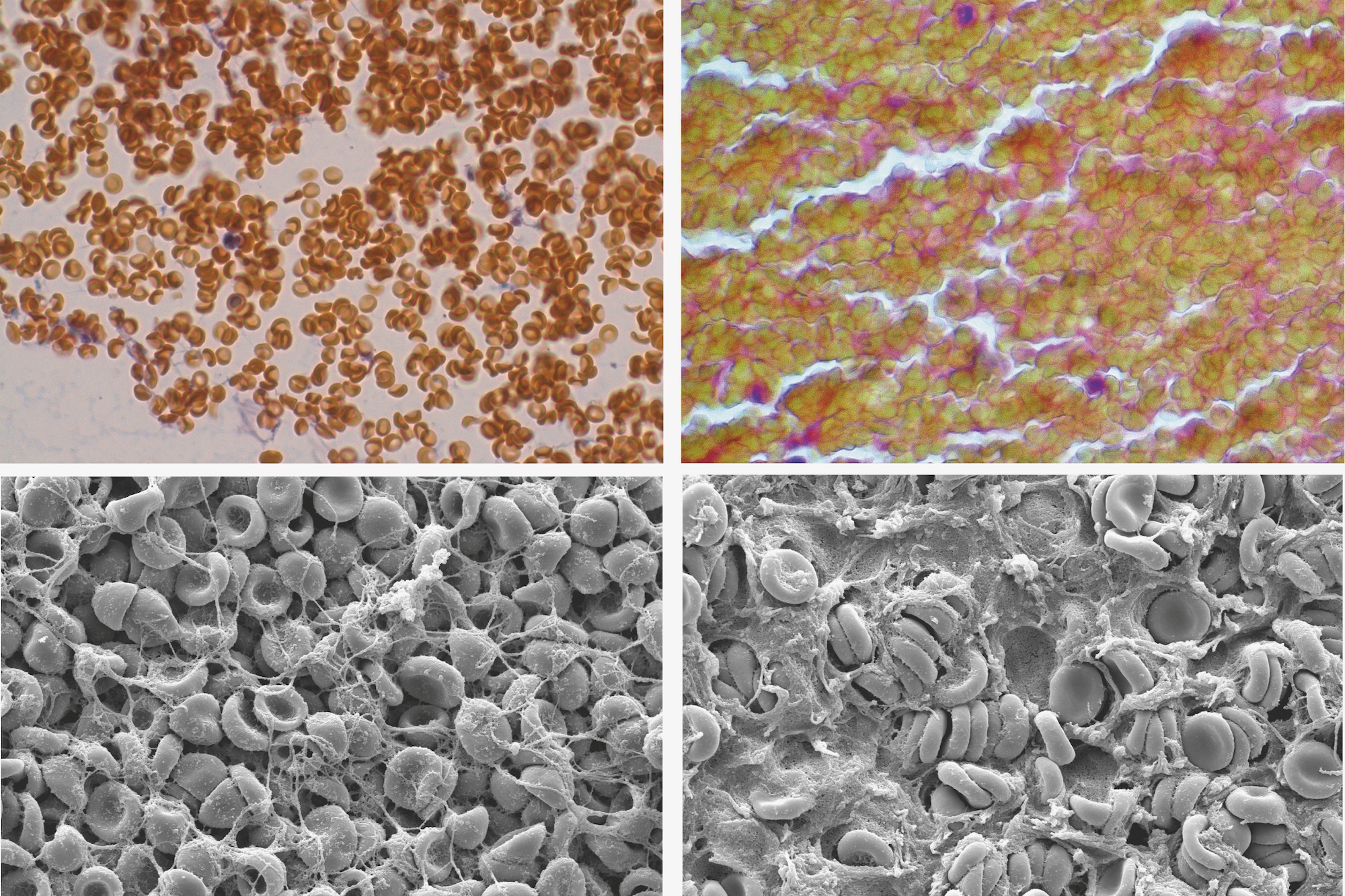Greg Engel: And it turns out all of these quantum measurements are optically detected, so it’s very important to understand how the light interacts with these systems at a fundamental level in order to make the measurements work properly. So this allows us to dive into some biological systems, it allows us to look at new quantum technologies and sort exactly what’s going on and which couplings are either driving the technology or hindering it and allows us to engineer. At a fundamental level, you just can’t engineer what you can’t see, and so we give people the ability to see what’s going on.
Paul Rand: Tell me, if I came into your labs, what would I actually see? Back to this idea, what does the setup look like?
Greg Engel: Yeah, so it doesn’t look like a normal chemistry lab. Let’s just start with that. There are 6,000 pounds of optical tables floating on a bed of nitrogen in the air. So if you bump them, they jiggle around and the whole goal is to ensure that the laser systems stay perfectly aligned. So vibrations in these 6,000 pound steel tables are enough to hurt our measurements. Temperature changes. So our lab will hold under a 10th of a degree Fahrenheit and less than a 0.2% relative humidity year round. So it’s always 70 degrees in the lab and by which I mean, 70.0 degrees in the lab. And that’s important because as things expand and contract, the distance that they change, even though it’s microscopic, is enough to ruin our measurements. And so it’s a dark, dimly lit lab with a 6,000 pound T-shaped table sitting in the middle of the lab floating about three feet above the floor on a bed of nitrogen.
Paul Rand: One of the concepts probably many people are familiar with is photosynthesis, and you’ve done a lot of work in that area. Talk to me about what you’ve been discovering in relation to photosynthesis.
Greg Engel: Photosynthesis is just a magical process, so all of the energy that we consume on earth comes from the sun. What I want to understand is how you move energy from one place to another efficiently without losing information, without losing energy. And it turns out that bacteria and plants have been working on this problem for 2.4 billion years and they’ve gotten really good at it. Because if you can grow just a little bit faster than your neighbor, you’ll take over the world and you’ll look outside your window and everything will be green. And in a short version, that’s kind of the history of our planet. And so we look at some of the most ancient photosynthetic complexes in plants that are kind of like the Model T of the photosynthetic world. The way these work is totally different than the way we build our own technologies. We use something like silicon to both absorb the light and split the charge, that’s what our solar cells are.
Greg Engel: Biology does something different. It uses large antenna complexes to absorb the light and then it transfers that energy to a material that can split the charge. The reaction center, it’s also a protein complex. So we go in with our spectroscopy and we try to dissect the dynamics. And what we found is that in moving this energy around, it’s doing exactly the opposite of what I would’ve thought, which is ensure that energy doesn’t get lost as heat. Keep it away from the vibrations and the molecules, make sure that you’re not losing that energy and dissipating it. Instead, the dissipation actually drives the system. That perhaps was not unexpected, but the way it couples to the vibrations to drive it is very deterministic.
Greg Engel: It’s planned out, if you will, in the structure of the protein. And the idea in the past was that the energy sits there and then there’s sort of random motions that cause it to hop between different chromophores and it kind of hops through the system. You can almost think about it as sort of hopping from lily pad to lily pad to lily pad. That’s not quite the right approach. When something gets excited, waves then move out through the system, which affects all the nearby chromophores and those vibrations actually help transport the energy. And it’s that relationship between the initial excitation, the subsequent sort of ripples going out through the complex and the electronic coupling between the different things. It allows you to move energy in a very different way.
Paul Rand: So I’m going to keep pausing you because there’s such a big concept and it’s really easy to nod and go on, but I want to make sure that I’m really tracking with it. So it used to think the energy would be hopping, for lack of a better word, inside the plants, and you’re discovering that it actually comes in waves.
Greg Engel: That’s exactly right. And hopping, it turns out is the only option when you have a random environment surrounding you. That’s what we do in most of the systems that we build to transport energy for FRET, for biology. It turns out there’s something a little different happening in these evolved complexes that they are exploiting coherent vibrations in order to transport the energy, which can be more efficient and faster than the traditional models that we thought were describing the system.
Paul Rand: So the energy doesn’t just bounce around randomly looking like a path, like a ball bouncing down to one of those boards with pegs. Instead, it spreads out like a wave and explores all the paths at once using quantum mechanics and tiny protein vibrations kind of act like a rhythm section, keeping the wave in sync so it doesn’t fall apart as it steers the energy down the fastest route to where that then gets turned into fuel. It’s kind of like cheating at that game like Plinko by quietly using quantum physics to make sure it wins every time.
Greg Engel: Again, it’s like watching a car go by and seeing it go fast. You know it’s quick, but exactly why will allow you to reproduce those dynamics. And it turns out it’s this very delicate relationship between the vibrations and the electronic states inside the complex, something that we would typically ignore.
Paul Rand: Explain that a different way, the vibration between these states. Try a different way.
Greg Engel: All matter, all molecules are made up of different nuclei that are bonded together with electrons, and when you see something in the visible, like the green of your plant outside, that’s an electronic excitation. That’s rearranging the electrons in the molecule. When you think about heat, that’s the nuclei moving. So when you excite the electrons, typically that energy is lost as heat that just absorbs. It’s the color in your clothing, the color in the plant, everything that you see that’s colored works that way. And so you lose the energy from the electrons when it couples to the nuclei.
Greg Engel: And so if you want to be efficient, the basic idea is try to minimize that coupling. Don’t let the energy leak out into random nuclear motion of the atoms in the molecule. It turns out, if that motion isn’t random, then it can promote more efficient energy transfer. And that’s what these complexes have learned how to do. So we of course know that electrons couple to molecular motions, but we’ve never really found a good way to use that productively to promote energy transfer. Biology taught us that it’s possible and we’re trying to learn exactly how to copy those ideas.
Paul Rand: If we thought of a practical evolution of this and you said, “We’re understanding this better, so we’re going to translate it or look to translate it in a different way and for a different application.” Give me an idea of what that could look like or be thought of.
Greg Engel: Yeah, so more sensitive, faster cameras would be one example that typically when you make a camera with a pixel, the speed of the camera is related to the size of the pixel. So if you want to go fast, you need very small pixels. If you want to be very sensitive and collect a lot of light, you need very large pixels. And so it’s hard to do both of those things at once. But if you can make a very large pixel that transfers the energy to a very small charge separation, you can actually have the best of both worlds. So you can begin to think of new generations of cameras that will be able to acquire information in dim light, process that information faster, and that can be useful on satellites, that can be useful in self-driving cars. There are lots of different ways that you can think about situations where you need to get a lot of information very quickly.
Paul Rand: If we think about the photosynthesis, back to that and the efficiency of how it is done, could that translate for example, as we’re struggling in the world with climate issues and the need to have more efficient, do you see some of those learnings going into how we might even harness, store solar energy or other forms of energy?
Greg Engel: Yeah, so I’ll admit I dream about that kind of thing, and I think about ways that we might be able to use this for what people call the energy crisis, and I’d love to see it go that way. We’re not there now. I want to be honest about that. Right now we are talking about how to custom build molecular frameworks that will have of this, and it is about harvesting light, you’re right. But at least in the beginning, they’re going to be expensive. They’re going to be hard. If you’re going to tackle solar energy, you have to think about how many dollars per square meter. If you want to think about improving, say a camera, you can pay hundreds and hundreds of dollars, thousands of dollars for something that’s only a few millimeters in scale. And so right now we’re thinking about how to enable the technology and we’re thinking about applications that will allow us to drive the technology forward. I mean, it’s a hope and a dream that maybe it would someday do what you say, but at this point it’s no more than a dream.
Paul Rand: But what isn’t so far off at the moment is the plan to take some of what we’re learning in quantum biology and apply it to the world of quantum sensors, quantum technology, and then hopefully the emerging field of quantum medicine. That is after the break. If you’re getting a lot out of the important research shared on Big Brains, there’s another University of Chicago podcast network show you should check out. It’s called Not Another Politics Podcast. Not Another Politics Podcast provides a fresh perspective on the biggest political stories, not through opinions and anecdotes, but through rigorous scholarship, massive data sets, and a deep knowledge of theory. If you want to understand the political science behind the political headlines, then listen to Not Another Politics Podcast. Part of the University of Chicago Podcast Network. Engel and his colleagues hope to apply what they’ve learned from quantum biology to the development of all sorts of technologies in quantum medicine and computing. But first, they need to build better quantum sensors.
Greg Engel: First, let me put the quantum sensing community in context for things like quantum computing. In quantum computing, you need large arrays of qubits that are talking to one another and are completely isolated from their environment. Otherwise, the system simply isn’t going to work. In quantum sensing, it’s rather different. You need one qubit and you learn from its coupling to the environment. So we are a much nearer term technology than a quantum computer. I like to say we use the garbage pail of quantum computing. The qubit that doesn’t work because it couples to its environment, we pick up as a tool. One man’s trash is another man’s treasure. We pick this up as a tool and we use it precisely because it couples to its environment, so it can teach me something about the environment. And so we are going to learn about some fundamental processes in biology.
Greg Engel: This will allow us to understand how drugs are working, how drugs are petitioning around the cell, how cancer is growing and moving. And so the first things you’ll probably see coming out of this technology are not necessarily tools where you go to your doctor and the doctor is practicing medicine, is using quantum technology sort of on you, but rather you’re going to find that the drugs seem to get a little bit better.
Paul Rand: Got it.
Greg Engel: The pipeline to creating a drug and understanding its mechanism of action and getting it through FDA approval may become a little bit faster. And so what you’ll see in the beginning is that these tools are used in the laboratory to give us more certainty in what we’re developing and more ways to see how a drug is working and how it is not working, what might be the source of a side effect. And so you’ll see it roll out in the laboratory first, and you may even be blind to how your drug was discovered or how it was developed or engineered, but things will start to work a little better.
Greg Engel: And then as it gets larger and cheaper and the equipment becomes a little less specialized, then you’ll see this move from research laboratories into academic and research hospitals and into the clinics. And it may go even farther, but we’ll have to see where that comes. The thing I do want to say to people is when we talk about quantum medicine, we’re talking about using quantum technology to improve the practice of medicine. We are not talking about giving someone a pill that is somehow quantum. It’s not a quantum pharmaceutical, so to speak.
Paul Rand: Got it, yep.
Greg Engel: It’s about using quantum technology to improve the delivery and practice of medicine. When we started working towards human biology, our first technologies were nitrogen vacancy centers in nanodiamonds, little pieces of diamond, tiny rocks, if you will, with a defect in them. And that system was obviously a quantum system. It was well known, it was well characterized, and then we’re putting it into this sort of soft, squishy environment to learn about human biology. But actually recently, David Awschalom, Peter Maurer, Aaron Esser-Kahn, Laura Gagliardi, the four of them created a protein version of that. And this just blows my mind.
Greg Engel: The ability to create a quantum sensor that is purely organic, that is built out of a protein, that is going to be transformative because now you don’t have to put something that’s, for lack of a better term, a rock into a cell, and then hope the cell behaves as it should. To be able to engineer with specificity the position and placement of these quantum sensors and have them be organic, have them be protein-based sensors, is going to be really exciting. So I think in the coming months and year, we’re going to see, forgive me, a quantum leap in this technology that is going to allow us to start making measurements that we couldn’t even dream of making just a few months ago.
Paul Rand: As you start thinking through some of the bigger, most vexing questions that you hope we start looking at in the next 10 years when it comes to quantum biology, where does your wish list go?
Greg Engel: Yeah, so there are a few emerging trends in biology and medicine that I think are very exciting. The ability to control and harness the immune system to address diseases, to include cancer and others. And then the ability to make measurements using quantum sensors to understand how the immune system is actually working and recognizing non-self and bringing those tools together so that we can have better drugs, better treatments for people, I think that’s one where it’s going to be really exciting. Another is neuroscience, where the quantum sensors are phenomenally good at measuring electric fields. And so this is how nerves communicate to one another. Now, we have other tools that do that very well right now, but it turns out there are a lot of membranes inside the cells that communicate in the same way. And we don’t have the tools to look at how that’s happening between different types of cells and within cells.
Greg Engel: And so I think this is going to open up areas of cellular biology that we just have been completely unable to access before. And we’ll learn about disease states, we’ll learn about treatments, we’ll be able to see what the drugs are doing, and I think that’s going to open up a broad new space for improving the delivery of human healthcare, making it a little more accurate, making a little slightly better outcomes, making it a little bit cheaper. And so much of our economy is driven towards human health and preserving health.
Paul Rand: Absolutely.
Greg Engel: And if we can make that even a little bit better, I think we can have a huge economic impact with these technologies.
Paul Rand: All right, Greg. Well, you’ve had a big announcement recently, didn’t you? It got some nice attention.
Greg Engel: So a donor, Thea Berggren, a philanthropist in Chicago, gave the University of Chicago $21 million to create the Berggren Center for Quantum Biology and Medicine. And the goal of this center is to bring leaders in quantum technology and quantum metrology together with clinicians and doctors to think about ways to better human health with quantum technology.
Paul Rand: And I think if I understood what you’re saying, part of what you’re doing is knowing that biologists, quantum scientists, physicists are looking at the world differently and talking differently and thinking about problems differently. And your idea is to bring students into this mix and really start being a bridge of communicating between these different audiences to think how they can work together. Is that basically the thrust behind the model?
Greg Engel: Absolutely. So one of the things that became clear to us very early on is that the physicists, the engineers, the chemists, the biologists and the physicians were all effectively speaking languages. We grew up in our own disciplines, and of course we have broad interests beyond exactly what we do, but it’s very hard to understand that the cutting edge of science, what someone else is working on. But one tool to move beyond some of those language barriers is to train students who have a foot in each of these two different fields where they feel themselves a full member of the biological community and a full member of the quantum technology community. And as they grow up there, they just learn very naturally how to speak to both of these groups, and they in effect are the translators. And it takes only a little bit of that to get someone extremely excited about the opportunities in an adjacent field. And once you have that hook, we find that the entire research group suddenly changes its focus and changes its tone. And we raise a generation of researchers who are excited about talking across disciplines.
Matt Hodapp: Big Brains is a production of the University of Chicago Podcast Network. We’re sponsored by the Graham School. Are you a lifelong learner with an insatiable curiosity? Access more than 50 open enrollment courses every quarter. Learn more at graham.uchicago.edu/bigbrains. If you like what you heard on our podcast, please leave us a rating and review. The show is hosted by Paul M. Rand, and produced by Lea Ceasrine and me, Matt Hodapp. Thanks for listening.







